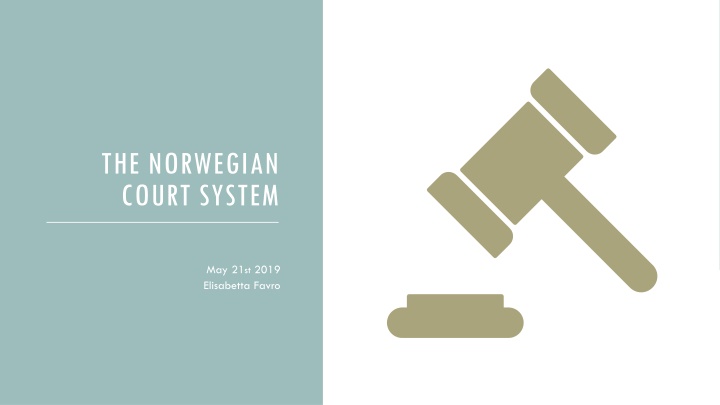
The Norwegian Court System: Historical Evolution & Key Structures
Explore the historical evolution and key structures of the Norwegian court system, from its inception in 950 to the establishment of the Supreme Court in 1815. Learn about the different levels of courts, including District Courts, Courts of Appeal, and the Supreme Court, as well as their jurisdictions and functions.
Download Presentation

Please find below an Image/Link to download the presentation.
The content on the website is provided AS IS for your information and personal use only. It may not be sold, licensed, or shared on other websites without obtaining consent from the author. If you encounter any issues during the download, it is possible that the publisher has removed the file from their server.
You are allowed to download the files provided on this website for personal or commercial use, subject to the condition that they are used lawfully. All files are the property of their respective owners.
The content on the website is provided AS IS for your information and personal use only. It may not be sold, licensed, or shared on other websites without obtaining consent from the author.
E N D
Presentation Transcript
THE NORWEGIAN COURT SYSTEM May 21st 2019 Elisabetta Favro
PRESENTATION Main historical points The court system Lay judges
950: creation of ting 1300: King Haakon V and appeal to the king SOME MAIN HISTORICAL POINTS 1607: introduction of instances to appeal 1661: Supreme Court in Copenhagen 1797: high courts replace courts of appeal 1995: district courts become the first instance for all matters
Ordinary/extraordinary courts of justice Ordinary courts: three levels District courts (63) Courts of appeal (6) Supreme Court THE COURT SYSTEM No constitutional court
DISTRICT COURTS (TINGRETT) Jurisdiction in all matters Conciliation boards (forliksr d) 3 lay members + 3 deputies not all matters excluded: Family law Trademark and patent issues Cases against authorities Cases with an opinion issued by an independent complaints committee
DISTRICT COURTS CRIMINAL CASES CIVIL CASES Number of judges Full confession + defendant agrees 1 professional Regular trials 3 (1 professional, 2 lay) Difficult cases 5 (2 professional, 3 lay) Number of judges 1 professional + 2 lay demanded by each party (optional) + 2 lay demanded by the law in certain cases Majority of votes for verdicts and sentences
COURTS OF APPEAL (LAGMANNSRETT) Right to appeal - Civil cases - Criminal cases Screening committee Cases with more than 6 years imprisonment must proceed If a case will clearly be not successful it can be decided by the s.c. CIVIL CASES 3 professional judges (+2/4 lay judges) CRIMINAL CASES < 6 years 7 judges (3 p., 4 l.) 5/7 for conviction > 6 years 3 p.j. + 10 jurors 7/10 for conviction Verdict can be set aside by p.j. for a retrial
SUPREME COURT (HYESTERETT) Estabilished in 1815 20 members appointed by the King Right to appeal heavily restricted Functions: Uniformity of legal process Resolution of matters on which the law is unclear Evolution of the law
SUPREME COURT 4 institutional forms Committee of 3 justices interlocutory orders and appeals against judgments (leave to proceed) Panel of 5 justices daily work Grand Chamber, 11 justices compatibility statutory law/Constitution and international conventions Plenary session, 20 justices compatibility statutory law/human rights conventions SUPREME COURT S APPEAL COMMITTEE (H yesteretts ankeutvalg) 3 Supreme Court justices appointed by the Chief Justice Proceedings in writing Leave from the A.C. is required for penal cases from the Court of appeal and in civil cases where the appeal < 100.000 NOK Rejects appeals if the possibility of success is obviously non-existent
Appointed by the local authority for a period of 4 years Judgement by peers Civil and criminal cases LAY JUDGES Expert lay judges Judges/jury Drawn from two panels (men and women) Counterbalance to official power
THANK YOU FOR YOUR ATTENTION






















